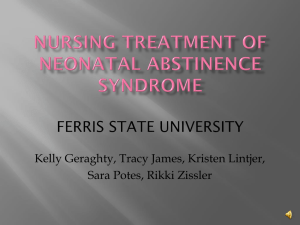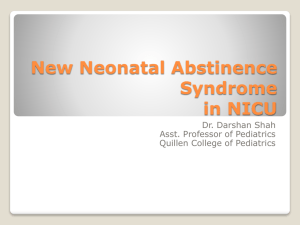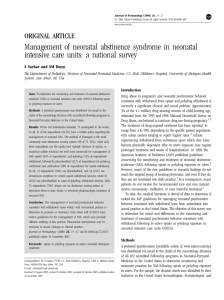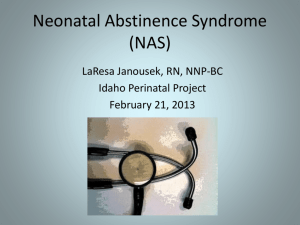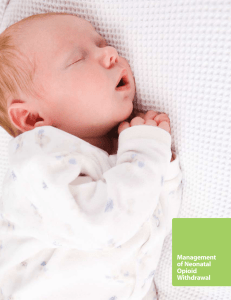Treating Infants with Methadone - National Association of State
advertisement
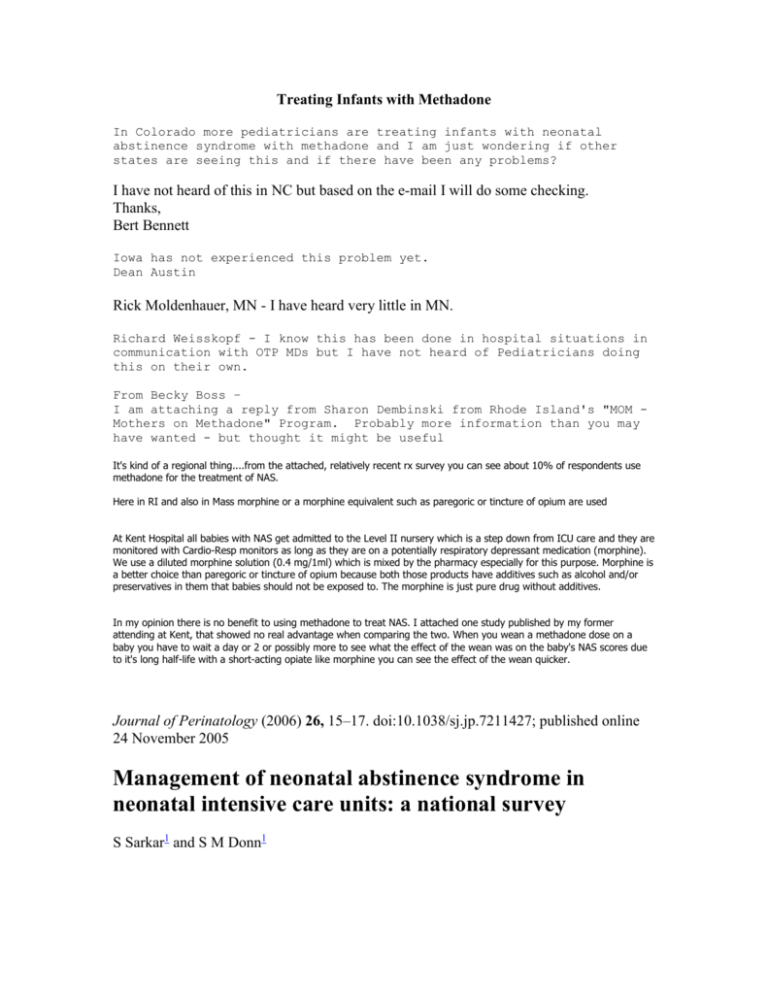
Treating Infants with Methadone In Colorado more pediatricians are treating infants with neonatal abstinence syndrome with methadone and I am just wondering if other states are seeing this and if there have been any problems? I have not heard of this in NC but based on the e-mail I will do some checking. Thanks, Bert Bennett Iowa has not experienced this problem yet. Dean Austin Rick Moldenhauer, MN - I have heard very little in MN. Richard Weisskopf - I know this has been done in hospital situations in communication with OTP MDs but I have not heard of Pediatricians doing this on their own. From Becky Boss – I am attaching a reply from Sharon Dembinski from Rhode Island's "MOM Mothers on Methadone" Program. Probably more information than you may have wanted - but thought it might be useful It's kind of a regional thing....from the attached, relatively recent rx survey you can see about 10% of respondents use methadone for the treatment of NAS. Here in RI and also in Mass morphine or a morphine equivalent such as paregoric or tincture of opium are used At Kent Hospital all babies with NAS get admitted to the Level II nursery which is a step down from ICU care and they are monitored with Cardio-Resp monitors as long as they are on a potentially respiratory depressant medication (morphine). We use a diluted morphine solution (0.4 mg/1ml) which is mixed by the pharmacy especially for this purpose. Morphine is a better choice than paregoric or tincture of opium because both those products have additives such as alcohol and/or preservatives in them that babies should not be exposed to. The morphine is just pure drug without additives. In my opinion there is no benefit to using methadone to treat NAS. I attached one study published by my former attending at Kent, that showed no real advantage when comparing the two. When you wean a methadone dose on a baby you have to wait a day or 2 or possibly more to see what the effect of the wean was on the baby's NAS scores due to it's long half-life with a short-acting opiate like morphine you can see the effect of the wean quicker. Journal of Perinatology (2006) 26, 15–17. doi:10.1038/sj.jp.7211427; published online 24 November 2005 Management of neonatal abstinence syndrome in neonatal intensive care units: a national survey S Sarkar1 and S M Donn1 1 The Department of Pediatrics, Division of Neonatal-Perinatal Medicine, C.S. Mott, Children's Hospital, University of Michigan Health System, Ann Arbor, MI, USA Correspondence: Dr S Sarkar, F5790 C.S. Mott Children's Hospital, 1500 E. Medical Center Drive, 48109-0254 Ann Arbor, MI, USA. E-mail: subratas@med.umich.edu Received 22 August 2005; Revised 19 October 2005; Accepted 28 October 2005; Published online 24 November 2005. Top of page Abstract Aims: To determine the monitoring and treatment of neonatal abstinence syndrome (NAS) in neonatal intensive care units (NICUs) following opiate or polydrug exposure in utero. Methods: A pretested questionnaire was distributed via email to the chiefs of the neonatology divisions with accredited Fellowship programs in Neonatal-Perinatal Medicine in the United States. Results: Of the 102 individuals contacted, 75 participated in the survey. In all, 41 of the respondents (54.5%) have a written policy regarding the management of neonatal NAS. The method of Finnegan is the most commonly used abstinence scoring system (49 of 75, 65%), while only three respondents use the Lipsitz tool. Opioids (tincture of opium, or morphine sulfate solution) are used most commonly for management of both opioid (63% of respondents) and polydrug (52% of respondents) withdrawal, followed by phenobarbital (32 % of respondents) for polydrug withdrawal and methadone (20% of respondents) for opioid withdrawal. In all, 53 respondents (70%) use phenobarbital, and 19 (25%) use intravenous morphine to control opioid withdrawal seizures, while 61 (81%) use phenobarbital in cases of polydrug withdrawal seizures. Only 53 respondents (70%) always use an abstinence scoring system to determine when to start, titrate, or terminate pharmacologic treatment of neonatal NAS. Conclusion: The management of neonatal psychomotor behavior consistent with withdrawal varies widely, with inconsistent policies to determine its presence or treatment. Only about half of NICUs have written guidelines for the management of NAS, which may preclude effective auditing of this practice. Educational interventions may be necessary to ensure changes in clinical practice. A Chart Review Comparing Paregoric to Methadone in the Treatment of Neonatal Opioid Withdrawal Page Range: 27 - 33 DOI: 10.1300/ Status: Prepublication Contributors: Martha J. Wunsch, Discipline of Addiction Medicine, Department of Pediatrics, Edward Via Virginia College of Osteopathic Medicine, Blacksburg, VA, 24060, mwunsch@vcom.vt.edu Purchase This Subscription Login To This Page Abstract: Neonatal opioid withdrawal often requires treatment but there have been few recent studies of current pharmacological interventions to guide treatment. This retrospective chart review provides an exploratory examination of newborns treated with either methadone or paregoric for opioid withdrawal and outlines dosage ranges and intervals, side effects, and clinical outcomes of the two regimens. The outcome variables examined were time to resolution of withdrawal symptoms, rate of decrease in symptom severity, and length of hospital stay. There were no observed differences in outcome variables between the two treatment groups and side effect profiles were similar. Dosages, dosage intervals, and tapering regimens were consistent with American Academy of Pediatrics recommendations. Although the sample size is small and standardized regimens were not used, this study provides preliminary data about dosing levels and dosing intervals of these two pharmacologic treatment agents. Both groups of infants had favorable outcomes, although given the variation in treatment regimens it is difficult to draw an equation of equivalency. These results are applicable to the design of future studies of pharmacological interventions. Journal Title: Journal of Addictive Diseases Volume: 25 Issue: 3 ISSN: 1055-0887
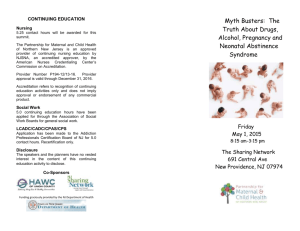

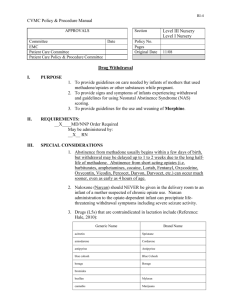
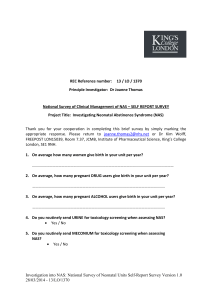
![NAS Guidelines [DOC]](http://s3.studylib.net/store/data/006668177_1-aff62a5ac7f530d592a4f88ece984b7b-300x300.png)
